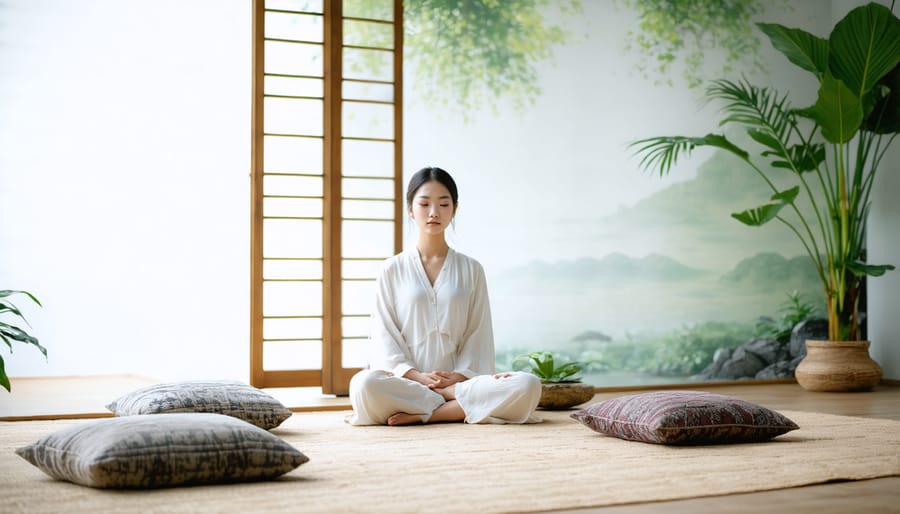
Close your eyes and settle into a comfortable position, letting your breath naturally flow as you turn your awareness inward. Like waves gently rolling onto shore, your emotions are constantly moving through you – sometimes subtle, sometimes intense, but always worthy of your attention and understanding.
Mindful emotion awareness meditation bridges the gap between traditional mindfulness practices and emotional intelligence, offering a powerful way to navigate your inner landscape with grace and wisdom. This practice isn’t about changing or fixing your feelings – it’s about creating space to acknowledge them with curiosity and compassion, much like watching clouds drift across the sky without trying to alter their path.
Whether you’re dealing with workplace stress, relationship challenges, or simply seeking deeper self-understanding, this meditation technique helps you develop a more nuanced relationship with your emotional world. By learning to observe your feelings without becoming overwhelmed by them, you’ll discover a natural pathway to emotional balance and resilience that serves you both on and off the meditation cushion.
The Body-Emotion Connection

Understanding Your Body’s Emotional Language
Have you ever noticed how your shoulders tense up during a stressful meeting, or how your stomach feels like it’s doing somersaults before a big presentation? Our bodies are constantly speaking to us through these physical sensations, acting as emotional messengers we often overlook in our busy lives. Through practices like mindful movement body scans, we can learn to decode these messages and better understand our emotional landscape.
Think of your body as an emotional GPS system. Anxiety might show up as a racing heart or sweaty palms, while joy could manifest as a warm feeling in your chest or relaxed muscles. By tuning into these physical cues, you’re developing what I like to call your “emotional vocabulary” – the unique way your body communicates its feelings to you. The beauty of this awareness is that it helps you catch emotional responses early, giving you the power to respond thoughtfully rather than react automatically to life’s challenges.
Common Physical-Emotional Patterns
Have you ever noticed how your shoulders tense up when you’re stressed, or your stomach flutters with excitement? Our bodies are incredible storytellers when it comes to our emotions. When we feel anxious, we might experience a racing heart, shallow breathing, or tight chest. Joy often shows up as warmth spreading through our body, relaxed muscles, and an urge to smile or move.
Anger typically manifests as heat in the face, clenched fists, or a tightening jaw, while sadness might bring heaviness to our limbs and a hollow feeling in our chest. Understanding these physical-emotional connections is like learning a new language – the language your body speaks.
As you practice mindful emotion awareness, start noticing your own unique patterns. Maybe you carry stress in your neck, or perhaps anxiety shows up as butterflies in your stomach. These physical cues become your personal emotional compass, helping you recognize and respond to your feelings more effectively.
Getting Started with Mindful Emotion Awareness
Creating Your Meditation Space
Creating a dedicated meditation space doesn’t require an entire room – even a cozy corner can become your sanctuary. I learned this when I first started my mindfulness journey in my tiny apartment, where a simple cushion by the window became my daily retreat.
Start by choosing a quiet spot where you won’t be disturbed. Add comfortable seating – this could be a meditation cushion, a soft blanket, or even a supportive chair. The key is finding what works best for your body and practice.
Consider incorporating elements that engage your senses: a soft-scented candle, a small indoor plant, or a beautiful crystal. Keep the space clutter-free and minimal – this helps maintain focus during your practice. Natural light is wonderful, but if that’s not possible, soft lighting from a lamp works beautifully too.
Personalize your space with meaningful items that bring you peace – perhaps a favorite photo or an inspiring quote. Remember, this is your personal sanctuary for emotional awareness work, so it should feel authentic to you. Just ensure everything within reach serves your practice rather than creates distractions.

Basic Meditation Techniques
Let’s start with a simple exercise I love to practice: find a comfortable spot, whether it’s your favorite chair or a quiet corner of your home. Close your eyes and take three deep breaths. Notice how your body feels in this moment – no judgment, just gentle awareness.
As you settle in, imagine your emotions as waves in an ocean. Some days they’re gentle ripples, others they’re powerful swells. The key is learning to observe them without getting swept away. Start by scanning your body from head to toe, paying attention to any physical sensations that might be connected to your emotions – perhaps a tightness in your chest when you’re anxious or warmth in your cheeks when you’re happy.
I’ve found it helpful to set a timer for just five minutes when starting out. During this time, simply notice whatever emotions arise. Label them softly in your mind: “Here’s anxiety,” “This is joy,” or “I’m feeling uncertainty.” Remember, you’re not trying to change anything – you’re just becoming aware.
If your mind wanders (and it will – mine still does!), gently guide your attention back to your emotional landscape. Try using an anchor, like your breath or the feeling of your hands resting in your lap, to stay present when emotions feel overwhelming.
Practice this exercise daily, ideally at the same time. Many of my readers find early morning or just before bed works best. As you develop this practice, you’ll start noticing patterns in your emotional responses and develop a deeper understanding of your inner world.
Remember, there’s no “perfect” way to do this – your journey of emotional awareness is uniquely yours.
Integrating Movement with Emotional Awareness
Simple Movement Exercises
Movement doesn’t have to be complicated to be meaningful. I discovered this myself when I started incorporating simple exercises into my meditation practice. These gentle movements can help you reduce anxiety through mindful movement while deepening your emotional awareness.
Start with shoulder rolls – slowly roll your shoulders forward and backward while noticing any tension or resistance. Pay attention to how different emotions might manifest as physical sensations in this area. Next, try gentle neck stretches, turning your head slowly from side to side, connecting with how your mood influences the fluidity of movement.
Standing hip circles are another powerful exercise. Place your hands on your hips and move them in slow, deliberate circles. This movement often helps release stored emotions we carry in our lower body. Finally, practice mindful walking in place, lifting each foot with intention and noticing how your emotional state affects your balance and rhythm.
Remember, these movements aren’t about perfection – they’re about creating a deeper connection between your physical sensations and emotional landscape. Start with just a few minutes daily, and allow yourself to explore these movements with curiosity and compassion.
Mindful Walking Practice
One of my favorite ways to blend movement with emotional awareness is through mindful walking. Find a quiet path or even pace around your living room – any space where you can walk comfortably for 10-15 minutes will do. Begin by standing still and taking three deep breaths, noticing how your body feels in this moment.
As you start walking, move at a slower pace than usual. Feel each step – from the moment your heel touches the ground to when your toes lift off. Notice the shifting of your weight and the natural swing of your arms. While walking, tune into any emotions that arise. Maybe you feel peaceful, anxious, or even impatient – whatever emerges, simply acknowledge it without judgment.
Pay attention to how your emotions might affect your walking pace or posture. Are you rushing when anxious? Dragging your feet when feeling low? This awareness creates a beautiful connection between your physical movement and emotional state. Remember, this isn’t about changing anything – it’s about being present with whatever shows up, step by step.
If your mind wanders, gently return your focus to the sensation of walking and your emotional landscape. This practice helps ground your emotional awareness in physical movement, making it easier to stay present with your feelings.

Making It Part of Your Daily Routine
Making mindful emotion awareness a regular part of your day doesn’t have to feel overwhelming. As someone who once struggled to maintain consistency, I’ve discovered that the key is starting small and building from there. Begin by setting aside just five minutes each morning, perhaps right after your morning coffee or during your commute (if you’re not driving).
Try anchoring your practice to existing habits – this makes it feel more natural and sustainable. For instance, you might practice awareness while brushing your teeth, taking a shower, or waiting for your lunch to heat up. These moments become perfect opportunities to check in with your emotional state.
Another approach that works wonderfully is creating “emotion check-in points” throughout your day. Set gentle reminders on your phone for 2-3 specific times, and when they go off, take a brief pause to notice what you’re feeling. This can be as simple as taking three mindful breaths and acknowledging your current emotional state.
For busy days, consider incorporating this practice into your existing daily holistic practices. Whether you’re doing yoga, taking an afternoon walk, or winding down before bed, these moments are perfect for emotional awareness work.
Remember, consistency matters more than duration. Even one minute of mindful awareness is valuable. Start where you are, and gradually expand your practice as it begins to feel more natural. The goal isn’t perfection but rather building a sustainable relationship with your emotional landscape that enriches your daily life.
Embarking on a mindful emotion awareness meditation practice can be truly transformative for your overall well-being. As someone who started this journey years ago, I can personally attest to the profound impact it’s had on my emotional intelligence and daily interactions. Through consistent practice, you’ll discover a deeper connection with yourself, enhanced self-awareness, and greater emotional resilience.
Remember, this practice isn’t about perfection – it’s about progress and self-discovery. Whether you’re dealing with workplace stress, relationship challenges, or simply seeking inner peace, incorporating these meditation techniques into your routine can help you navigate life’s ups and downs with greater ease and grace.
I encourage you to start small, perhaps with just five minutes a day, and gradually build your practice. Be patient and gentle with yourself as you explore this powerful tool for emotional well-being. The journey of mindful emotion awareness is deeply personal, and every step forward is a victory worth celebrating.
Take that first step today – your future self will thank you for it.



